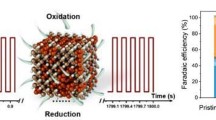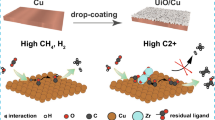Abstract
Electrocatalytic CO2 reduction reaction (CO2RR) to produce multicarbon (C2+) products over Cu-based catalysts represents an ideal approach for renewable energy storage and carbon emissions reduction. The Cu0/Cuδ+ interfaces are widely recognized as crucial sites that promote C–C coupling and enhance the generation of C2+ products. However, a major challenge arises from the tendency of Cuδ+ active sites within Cu0/Cuδ+ interfaces to undergo reduction to Cu0 during the CO2RR process, leading to a decline in catalytic performance. Hence, it is crucial to establish durable Cu0/Cuδ+ interfaces to enhance the conversion of CO2 to C2+ products. In this work, an iodine modification strategy is proposed to prepare a stable Cu@CuI composite catalyst with well-maintained Cu0/Cuδ+ interfaces through a one-step redox reaction between iodine and copper. The optimized Cu@CuI-3 composite catalyst demonstrates an excellent performance in CO2RR, achieving a Faradaic efficiency of 75.7% for C2+ products and a partial current density of 288 mA·cm−2 at − 1.57 VRHE in a flow cell. Operando techniques reveal that a numerous persistent Cuδ+ species exist on the surface of the Cu@CuI-X composite catalyst even after CO2RR due to the presence of adsorbed iodine ions, which prevent complete reduction of Cuδ+ species to Cu0 owing to their high electronegativity. Density functional theory calculations further verify that adsorbed iodine ions on the surface of Cu@CuI-X serve as charge regulators by adjusting local charge density, thereby facilitating the formation of *CHO intermediates from CO2 and lowering the energy barriers associated with coupling the *CHO and *CO intermediates during CO2RR. Consequently, this phenomenon enhances the selectivity toward C2+ products during electrocatalytic CO2 reduction.
Graphical abstract

摘要
在铜基催化剂上进行电催化二氧化碳还原反应(CO2RR)生成多碳(C2+)产物,是一种理想的可再生能源储存和碳减排方法。Cu0/Cuδ+界面被广泛认为是促进 C-C 偶联和促进C2+产物生成的关键位置。然而,Cu0/Cuδ+界面中的Cuδ+活性位点在CO2RR过程中容易被还原成 Cu0,从而导致催化性能衰减,这是目前面临的一个重大挑战。因此,建立持久的 Cu0/Cuδ+界面对于促进 CO2 还原成C2+产物至关重要。在这项工作中,我们介绍了一种碘改性策略,通过碘和铜之间的一步氧化还原反应制备具有稳定 Cu0/Cuδ+界面的 Cu@CuI 复合催化剂。优化后的Cu@CuI-3复合催化剂具有优异的 CO2RR 性能,在流动池中的C2+法拉第效率达到75.7%,−1.57 VRHE 时的部分电流密度达到 288 mA·cm‒2。通过原位技术,我们发现即使在 CO2RR 之后,Cu@CuI-X 复合催化剂上仍然存在大量的Cuδ+物种,这是因为吸附了碘离子,而碘离子的高电负性阻止了Cuδ+物种完全还原为Cu0。密度泛函理论计算进一步验证了Cu@CuI-X上吸附的碘离子可作为电荷调节器,调整局部电荷密度,加速 CO2 转化为 *CHO 中间体,并降低*CHO和*CO中间产物耦合的能垒。因此,这种现象提高了 CO2RR 过程中 C2+ 产物的选择性。




Similar content being viewed by others
References
Xu QJ, Jiang JW, Wang XF, Duan LY, Guo H. Understanding oxygen vacant hollow structure CeO2@In2O3 heterojunction to promote CO2 reduction. Rare Met. 2023;42(6):1888. https://doi.org/10.1007/s12598-022-02244-2.
Shen SQ, Wang GS, Yan FF, Yuan T. Research progress in MOF derived transition metal single atomic catalysts for oxygen reduction reaction. Chin J Rare Met. 2023;47(01):28. https://doi.org/10.13373/j.cnki.cjrm.XY22080014.
Zheng SJ, Cheng H, Yu J, Bie Q, Chen JD, Wang F, Wu R, Blackwood DJ, Chen JS. Three-dimensional ordered porous N-doped carbon-supported accessible Ni–Nx active sites for efficient CO2 electroreduction. Rare Met. 2023;42(6):1800. https://doi.org/10.1007/s12598-022-02247-z.
Liu JB, Gong HS, Ye GL, Fei HL. Graphene oxide-derived single-atom catalysts for electrochemical energy conversion. Rare Met. 2022;41(5):1703. https://doi.org/10.1007/s12598-021-01904-z.
Chang B, Pang H, Raziq F, Wang SB, Huang KW, Ye JH, Zhang HB. Electrochemical reduction of carbon dioxide to multicarbon (C2+) products: challenges and perspectives. Energ Environ Sci. 2023;16(11):4714. https://doi.org/10.1039/D3EE00964E.
Wei X, Yin ZL, Lyu KJ, Li Z, Gong J, Wang GW, **ao L, Lu JT, Zhuang L. Highly selective reduction of CO2 to C2+ Hydrocarbons at copper/polyaniline interfaces. ACS Catal. 2020;10(7):4103. https://doi.org/10.1021/acscatal.0c00049.
Zhan LS, Wang YC, Liu MJ, Zhao X, Wu J, **ong X, Lei YP. Hydropathy modulation on Bi2S3 for enhanced electrocatalytic CO2 reduction. Rare Met. 2023;42(3):806. https://doi.org/10.1007/s12598-022-02212-w.
Chen JL, Liao XL, Chen S, Lu TT, Sun XT, Cao LX, Wang H. Self-supported CuBi bimetal nanodendrites for CO2 electrochemical reduction. Copp Eng. 2023;1:1. https://doi.org/10.3969/j.issn.1009-3842.2023.01.001.
Liu M, Wang QY, Luo T, Herran MH, Cao XY, Liao WR, Zhu L, Li HM, Stefancu AS, Lu YR, Chan TS, Pensa EP, Ma C, Zhang SG, **ao RY, Cortés EC. Potential alignment in tandem catalysts enhances CO2-to-C2H4 conversion efficiencies. J Am Chem Soc. 2024;146(1):468. https://doi.org/10.1021/jacs.3c09632.
Li H, Chang SH, Zhang MM. Research progress on properties tuning and products of Cu–based catalyst in electrocatalytic CO2 reduction. Copp Eng. 2023;6:38. https://doi.org/10.3969/j.issn.1009-3842.2023.06.005.
Zi X, Zhou YJ, Zhu L, Chen Q, Tan Y, Wang XQ, Sayed MS, Pensa EP, Geioushy RAG, Liu K, Fu JW, Cortés EC, Liu M. Breaking K+ concentration limit on Cu nanoneedles for acidic electrocatalytic CO2 reduction to multi-carbon products. Angew Chem Int Edit. 2023;62(42):e202309351. https://doi.org/10.1002/anie.202309351.
Zhou YJ, Liang YQ, Fu JW, Liu K, Chen Q, Wang XQ, Li HM, Zhu L, Hu JH, Pan H, Miyauchi MM, Jiang LX, Cortés EC, Liu M. Vertical Cu nanoneedle arrays enhance the local electric field promoting C2 hydrocarbons in the CO2 electroreduction. Nano Lett. 2022;22(5):1963. https://doi.org/10.1021/acs.nanolett.1c04653.
Chen Q, Wang XQ, Zhou YJ, Tan Y, Li HM, Fu JW, Liu M. Electrocatalytic CO2 reduction to C2+ products in flow cells. Adv Mater. 2023;36(5):2303902. https://doi.org/10.1002/adma.202303902.
Li HF, Liu TF, Wei PF, Lin L, Gao DF, Wang GX, Bao XH. High-rate CO2 electroreduction to C2+ products over a Copper–Copper iodide catalyst. Angew Chem Int Edit. 2021;60(26):14329. https://doi.org/10.1002/anie.202102657.
Pan YP, Li YY, Dong CL, Huang YC, Wu JC, Shi JQ, Lu YX, Yang M, Wang SY, Zou YQ. Unveiling the synergistic effect of multi-valence Cu species to promote formaldehyde oxidation for anodic hydrogen production. Chem. 2023;9(4):963. https://doi.org/10.1016/j.chempr.2022.12.008.
Zhang ZY, Wang ZL, An K, Wang JM, Zhang SR, Song PF, Bando YB, Yamauchi YY, Liu Y. Ti3+ tuning the ratio of Cu+/Cu0 in the ultrafine Cu nanoparticles for boosting the hydrogenation reaction. Small. 2021;17(23):2008052. https://doi.org/10.1002/smll.202008052.
Chen HH, Li HB, Chen SQ, Sheng L, Zhang ZR, Wu WL, Fan MH, Wang LZ, Yang B. Atomic Pd dispersion in triangular Cu nanosheets with dominant (111) plane as a tandem catalyst for highly efficient and selective electrodehalogenation. Appl Catal B Environ. 2023;328:122480. https://doi.org/10.1016/j.apcatb.2023.122480.
Zhao BH, Chen FP, Cheng CQ, Li L, Liu CB, Zhang B. C60-stabilized Cu+ sites boost electrocatalytic reduction of CO2 to C2+ products. Adv Energ Mater. 2023;13(19):2204346. https://doi.org/10.1002/aenm.202204346.
Pankhurst JRP, Guntern YTG, Mensi MM, Buonsanti RB. Molecular tunability of surface-functionalized metal nanocrystals for selective electrochemical CO2 reduction. Chem Sci. 2019;10(44):10356. https://doi.org/10.1039/c9sc04439f.
Du RA, Wu QQ, Zhang SY, Wang P, Li ZJ, Qiu YC, Yan KY, Waterhouse GINW, Wang P, Li J, Zhao Y, Zhao WW, Wang X, Chen GX. Cu-C(O) interfaces deliver remarkable selectivity and stability for CO2 reduction to C2+ products at industrial current density of 500 mA cm-2. Small. 2023;19(28):2301289. https://doi.org/10.1002/smll.202301289.
Lim CYG, Yilmaz M, Arce-Ramos JM, Handoko AD, Teh WJ, Zheng YG, Khoo ZHJ, Lin M, Isaacs M, Tam TLD, Bai Y, Ng CK, Yeo BS, Sankar G, Parkin IP, Hippalgaonkar K, Sullivan MB, Zhang J, Lim Y. Surface charge as activity descriptors for electrochemical CO2 reduction to multi-carbon products on organic-functionalised Cu. Nat Commun. 2023;14:335. https://doi.org/10.1038/s41467-023-35912-7.
Fang MW, Wang ML, Wang ZW, Zhang ZX, Zhou HC, Dai LM, Zhu Y, Jiang L. Hydrophobic, ultrastable Cuδ+ for robust CO2 electroreduction to C2 products at ampere-current levels. J Am Chem Soc. 2023;145(20):11323. https://doi.org/10.1021/jacs.3c02399.
Kim T, Palmore GTR. A scalable method for preparing Cu electrocatalysts that convert CO2 into C2+ products. Nat Commun. 2020;11:3622. https://doi.org/10.1038/s41467-020-16998-9.
Varela AS, Ju W, Reier T, Strasser P. Tuning the catalytic activity and selectivity of Cu for CO2 electroreduction in the presence of halides. ACS Catal. 2016;6(4):2136. https://doi.org/10.1021/acscatal.5b02550.
Gao DF, Sinev I, Scholten F, Arán-Ais RM, Divins NJ, Kvashnina K, Timoshenko J, Cuenya BR. Selective CO2 electroreduction to ethylene and multicarbon alcohols via electrolyte-driven nanostructuring. Angew Chem Int Edit. 2019;58(47):17047. https://doi.org/10.1002/anie.201910155.
Yoon A, Poon J, Grosse P, Chee SW, Cuenya BR. Iodide-mediated Cu catalyst restructuring during CO2 electroreduction. J Mater Chem A. 2022;10(26):14041. https://doi.org/10.1039/d1ta11089f.
Zhou YS, Che FL, Liu M, Zou CQ, Liang ZQ, Luna PD, Yuan HF, Li J, Wang ZQ, **e HP, Li HM, Chen PN, Bladt E, Quintero-Bermudez R, Sham TK, Bals S, Hofkens J, Sinton D, Chen G, Sargent EH. Dopant-induced electron localization drives CO2 reduction to C2 hydrocarbons. Nat Chem. 2018;10:974. https://doi.org/10.1038/s41557-018-0092-x.
Li MH, Ma YY, Chen J, Lawrence R, Luo W, Sacchi M, Jiang W, Yang JP. Residual chlorine induced cationic active species on a porous copper electrocatalyst for highly stable electrochemical CO2 reduction to C2+. Angew Chem Int Edit. 2021;60(20):11487. https://doi.org/10.1002/anie.202102606.
Fan K, Jia YF, Ji YF, Kuang PY, Zhu BC, Liu XY, Yu JG. Curved surface boosts electrochemical CO2 reduction to formate via bismuth nanotubes in a wide potential window. ACS Catal. 2020;10(1):358. https://doi.org/10.1021/acscatal.9b04516.
Qu YF, Zheng W, Wang PC, Huang H, Huang MX, Hu L, Wang H, Chen QW. Creating interfaces of Cu0/Cu+ in oxide-derived copper catalysts for electrochemical CO2 reduction to multi-carbon products. J Colloid Interf Sci. 2023;645:735. https://doi.org/10.1016/j.jcis.2023.04.133.
Li HF, Wei PF, Gao DF, Wang GX. In situ Raman spectroscopy studies for electrochemical CO2 reduction over Cu catalysts. Curr Opin Green Sust Chem. 2022;34: 100589. https://doi.org/10.1016/j.cogsc.2022.100589.
Zhao Y, Zhang XG, Bodappa N, Yang WM, Liang Q, Radjenovica PM, Wang YH, Zhang YJ, Dong JC, Tian ZQ, Li JF. Elucidating electrochemical CO2 reduction reaction processes on Cu (hkl) single-crystal surfaces by in situ Raman spectroscopy. Energ Environ Sci. 2022;15(9):3968. https://doi.org/10.1039/d2ee01334g.
Gong Y, He T. Gaining deep understanding of electrochemical CO2RR with in situ/operando techniques. Small Methods. 2023;7(11):2300702. https://doi.org/10.1002/smtd.202300702.
Li H, Jiang K, Zou SZ, Cai WB. Fundamental aspects in CO2 electroreduction reaction and solutions from in situ vibrational spectroscopies. Chinese J Catal. 2022;43(11):2772. https://doi.org/10.1016/S1872-2067(22)64095-6.
Song XN, Xu L, Sun XF, Han BX. In situ/operando characterization techniques for electrochemical CO2 reduction. Sci China Chem. 2023;66:315. https://doi.org/10.1007/s11426-021-1463-6.
Yang RO, Duan JY, Dong PP, Wen QL, Wu M, Liu YW, Liu Y, Li HQ, Zhai TY. In situ halogen-ion leaching regulates multiple sites on tandem catalysts for efficient CO2 electroreduction to C2+ products. Angew Chem Int Edit. 2022;61(21):e202116706. https://doi.org/10.1002/anie.202116706.
Duan GY, Li XQ, Ding GR, Han LJ, Xu BH, Zhang SJ. Highly efficient electrocatalytic CO2 reduction to C2+ products on a poly(ionic liquid)-based Cu0–CuI tandem catalyst. Angew Chem Int Edit. 2022;61(9):e202110657. https://doi.org/10.1002/anie.202110657.
Acknowledgements
This work was financially supported by the National Natural Science Foundation of China (Nos. 52073009, 52272182, 51872013 and 52011530190), the Program of the Ministry of Education of China for Introducing Talents of Discipline to Universities (No. B14009).
Author information
Authors and Affiliations
Corresponding author
Ethics declarations
Conflict of interests
The authors declare that they have no conflict of interest.
Supplementary Information
Below is the link to the electronic supplementary material.
Rights and permissions
Springer Nature or its licensor (e.g. a society or other partner) holds exclusive rights to this article under a publishing agreement with the author(s) or other rightsholder(s); author self-archiving of the accepted manuscript version of this article is solely governed by the terms of such publishing agreement and applicable law.
About this article
Cite this article
Ding, SS., Wang, XP., Fang, MW. et al. Enhancing electrocatalytic reduction of CO2 to C2+ products with high efficiency at Cu0/Cuδ+ interfaces via iodine modification strategy. Rare Met. (2024). https://doi.org/10.1007/s12598-024-02840-4
Received:
Revised:
Accepted:
Published:
DOI: https://doi.org/10.1007/s12598-024-02840-4




